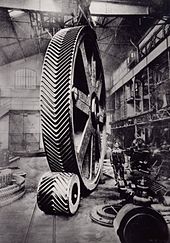Helical gearing
A helical toothing is an arrangement of the teeth in a gear that is not parallel to the axis of rotation . A differentiation is made between helical and straight teeth .
In the case of two pairs of external gears, a right-handed and left-handed helical toothing must always be combined to form a pair of gears. (In the photo of the gearbox, the large, wide gear is left-handed.)
Advantages of the helical gearing over the straight gearing
- Better running smoothness and less noise, since each pair of teeth runs with a continuous transition into and out of mesh and thus the transmission of torque is more even. The difference in noise can easily be seen in cars: the reverse gear is usually straight-toothed and makes a characteristic howling noise.
- Compared to a straight-toothed gear with comparable dimensions and the same number of teeth, the tooth root and pit load capacity is somewhat greater.
- Smaller numbers of teeth are possible without undercut .
- The center distance is determined by the helix angle and can be easily adapted to the required dimension.
Disadvantages of helical teeth compared to straight teeth
- An axial force component ( axial force ) is created which acts on the bearing and has to be compensated separately there. Alternatively, the axial force component can be prevented by using a herringbone gearing, which is complex to manufacture , whereby a left-handed and a right-handed half are combined on a gear. The use of the herringbone toothing became the trademark of Citroën . Likewise, by carefully selecting the helix angles of two gears on a shaft , the axial forces that arise counteract each other.
- With the same pressure angle in normal section (usually 20 °), the radial force component is higher, which also puts more stress on the bearings in the radial direction.
- Slightly higher power loss, also due to the higher bearing forces, and therefore somewhat poorer efficiency. In transmissions where the focus is almost exclusively on the degree of efficiency and the noise behavior does not play a role (transmissions in racing cars), straight-toothed gears are therefore mostly used.
- Slightly lower scuffing capacity .
- Usually higher manufacturing costs.
Use in helical gears
In so-called helical gears , the axes are not parallel, but skewed . Two helical gears are paired with each other. Both wheels are either right or left handed, and both have any helix angle. When pairing right and left-handed wheels, the helix angles must be different. The flanks of the two wheels only touch each other at points.
Web links
Wiktionary: helical gearing - explanations of meanings, word origins, synonyms, translations
Individual evidence
- ^ Siegfried Hildebrand : Feinmechanische Bauelemente , Hanser 1968, page 536


